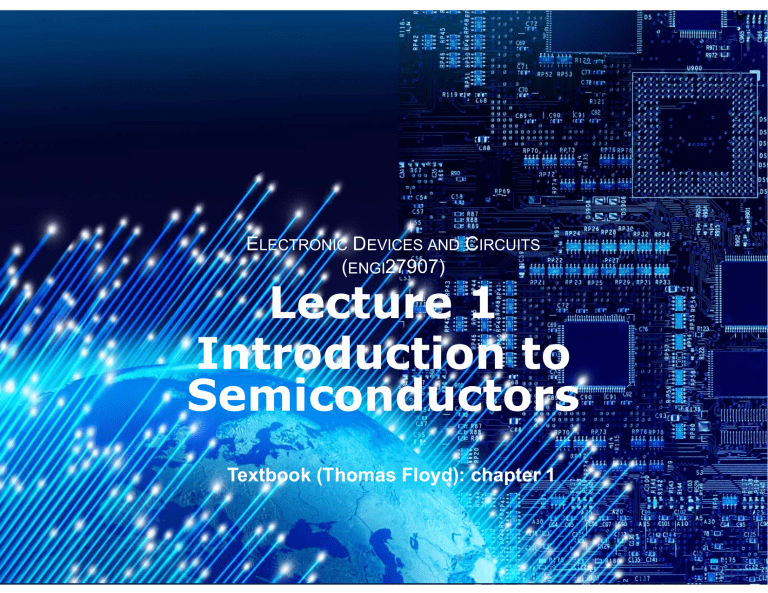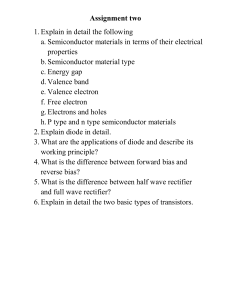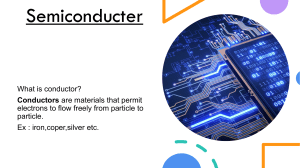
ELECTRONIC DEVICES AND CIRCUITS (ENGI27907) Lecture 1 Introduction to Semiconductors Textbook (Thomas Floyd): chapter 1 1 Outline READINGS This Session Lecture: Textbook (Thomas Floyd): chapter 1 QUIZ 1 Week 3 during scheduled lecture Make sure your laptop work well Arrive on time HOMEWORK 1 Do not submit but the earlier you complete the more benefit for your Lab and Quiz Due @the BEGINNING of next Lecture Introduction to Semiconductors Watch the video, answer the following questions: • What is semiconductor? • Why semiconductor is important? • What is the difference among conductor, insulator and semiconductor? https://www.semiconductors.org/semicon ductors-101/what-is-a-semiconductor 2:46 Conductors - Insulators - Semiconductors https://www.youtube.com/watch?v=0NBTvJF6ghQ 3 List of Topices • • • • • • • • Properties of insulators, conductors, and semiconductors Energy diagrams Charge Carriers: Electrons and Holes Electron Hole Pair Generation Electron Hole Pair Recombination n-type and p-type Semiconductor The pn Junction Introduction of Diodes 4 Conductor Materials • The valence shell (electrons) determines the ability of the material to conduct current. When a valence electron gains sufficient energy from an external source, it can break free from its atom, and become free electron. • Conductor materials can conduct electricity easily since they have many free electrons. • Most metals are good conductors. For example: Copper has one valence electron which is easy to escape. 5 Insulator Materials • Insulators have few free electrons for conduction; therefore, they do not conduct electricity current, and have very high resistivity. • Glass, air, paper, plastic and rubber are excellent insulators that are widely used in electronics. 6 Semiconductor Materials • Conductivity of semiconductor is between conductors and insulators. • Silicon is the most commonly used semiconductor • Silicon has 4 valence electrons which are shared among the neighboring silicon atoms to make strong covalent bonds. • Each silicon atom share valence electrons through covalent bonds with 4 adjacent silicon atoms to form a silicon crystal. Bonding diagram silicon crystal 7 Energy diagrams • The ability to conduct current for the three types of materials can be explained by energy diagrams • The valence shell of an atom represents a band of energy levels, call valence band, valence electrons are confined to valence band. • When an electron acquires enough additional energy, it can leave the valence shell, become a free electron, and exist in what is known as the conduction band. • The difference in energy between the valence band and the conduction band is called band gap. • • • Insulator has very big band gap Conductors has overlapped band gap at room temperatures This course focuses the study on semiconductor 8 Charge Carriers: Electrons and Holes • Free electrons in conduction band can move and contribute in the current flow. Electrons are negative charge carriers. • Electrons in valence band can also move between atoms. • Effectively free holes move in opposite direction and contribute in the current flow like positive charge carriers. 9 Electron Hole Pair Generation • Electrons can acquire energy and move from valence band to conduction band. This process generates one free electron in conduction band and one hole in valence band. • Current in a semiconductor is composed of electron current and hole current • Application: variable conduction with light (photocell). • Application: converting sunlight to electrical power (solar cells). • Issue: unwanted effect of temperature on electronic devices. Semiconductor has relatively narrow band gap 10 Electron Hole Pair Recombination • Electrons (in the conduction band) and holes (in the valence band) can recombine and release energy in the form of heat or light (photons). Free electrons and holes disappear in this process recombination • Application: Light Emitting Diodes • Issue: Electronic devices get warmer while operating. 11 n-type and p-type Semiconductor Conductivity of semiconductor can be increased by the addition of impurities • Doping: adding pentavalent impurity atoms such as Arsenic (As), Phosphorus (P), and Antimony (Sb). • These atoms share 4 valence electrons with neighboring Silicon atoms and easily release their 5th electron (donor impurity). • Results: increases the number of free electrons Creates positive impurity ions N-type • Doping: adding trivalent impurity atoms such as Boron (B), Aluminum (Al). • These atoms share 3 valence electrons with neighboring silicon atoms and should accept (acquire) the 4th electron to complete the bonds (acceptor impurity) • Results: Increases the number of free holes Creates negative impurity ions P-type The pn Junction After watch the video, answer the following questions: What is pn junction? How depletion region forms? PN Junction https://www.youtube.com/w atch?v=ar7xDMR4P_U 13 The pn Junction • n-side: free electrons diffuse toward p-side, recombine with free holes and leave positive ions. • p-side: free holes diffuse toward n-side, recombine with free electrons and leave negative ions. • A depletion region and a potential barrier is formed, depends on type of semiconductive material, the amount of doping, and the temperature. Typically 0.7 V for silicon, 0.3 V for germanium • The charge carriers’ transfer continues until the internal potential barrier becomes strong enough. • The pn junction is the basis for diodes, certain transistors, solar cells… 14 PN junction energy levels To an electron trying to diffuse across the junction, the path it must travel looks like an energy hill. It must receive the extra energy from an outside source (power supply) to climb the energy hill. Diode • A diode is a pn junction with metal contacts and leads. • Diodes control the direction of current-flow, conduct in one direction only. • Diode’s terminals are polarized 16 Diode Types signal diodes usually have a medium-high forward voltage drop and a low maximum current rating. E.g 1N4148. Through-hole LEDs. From left to right: yellow 3mm, blue 5mm, green 10mm, super-bright red 5mm, RGB 5mm and blue 7-segment LED. Zener Diodes are usually used to intentionally conduct reverse current surface-mount diode Schottky diode has smaller forward voltage drop (0.15V and 0.45V), very large breakdown voltage, useful in limiting losses, when voltage must be spared. A rectifier or power diode has much higher maximum current rating, with the cost of a larger forward voltage. E.g 1N4001 https://learn.sparkfun.com/tutorials/diodes/all 17 Typical diode packages with terminal identification • Through-hole diodes and surface mount diodes • Diodes come in a variety of sizes and shapes. The design and structure is determined by what type of circuit they will be used in • A for anode and K for cathode 18 Diode connection Forward bias • Positive voltage is applied to the anode. • The applied voltage is close to or greater than the potential barrier diode is on (conducting) + diode current would be significant. • When diode is forward biased: Depletion region become narrow. Potential barrier height is 0.7V for silicon diode. The current can be controlled by the applied voltage. the flow of majority carriers 19 Diode connection Reverse Bias Diode • Positive voltage is applied to the cathode. • The diode is off (not conducting); diode current is very small and can be negligible. • When diode is reverse biased: Depletion region become wide (application: variable capacitor with voltage) Potential barrier height increases. Current is almost zero (very small temperature dependent current). All voltage is dropped across the reverse diode. the minority carriers from thermally generated electron-hole pairs 20 Testing Diode with DMM • With the diode check function a good diode will show approximately .7 V or .3 V when forward biased. • When checking in reverse bias the full applied testing voltage will be seen on the display. K A A K Troubleshooting Diodes Open Diode: Diode check function: no current flows in either direction display full checking voltage for both forward and reverse connections. Ohmmeter: high resistance in both forward and reverse connections. Shorted Diode: Diode check function : maximum current flows 0 V Ohmmeter: low resistance for both forward and reverse connections. Summary • Diodes, transistors, and integrated circuits are all made of semiconductor material. • P-materials are doped with trivalent impurities • N-materials are doped with pentavalent impurities • P and N type materials are joined together to form a PN junction. • A diode is nothing more than a PN junction. • A depletion region is formed at PN junction. It creates a voltage barrier of .3 V for a Germanium and .7 V for Silicon for conduction to take place. • A diode conducts when forward biased and does not conduct when reverse biased


![Intro to Semiconductors and Diodes []](http://s2.studylib.net/store/data/005340797_1-9cc5e13687b40f30b11ab4990fa74479-300x300.png)


